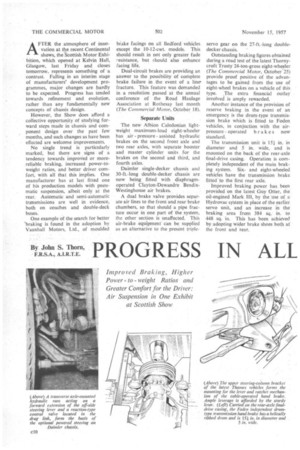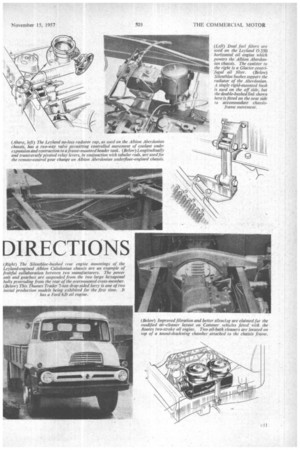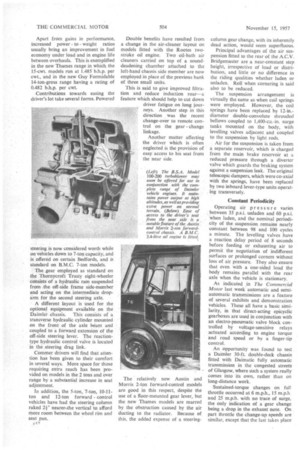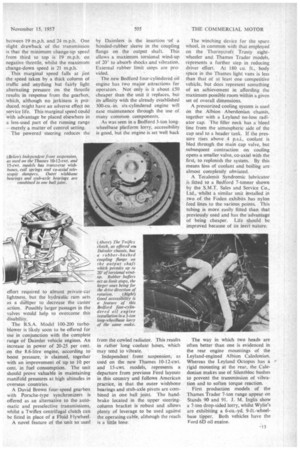B F y t J .S ohn S. Thorn , PROGRESS IN ALL
Page 46

Page 47

Page 48

Page 49

If you've noticed an error in this article please click here to report it so we can fix it.
DIRECTIONS
Apart from gains in performance, increased power to weight ratios usually bring an improvement in fuel economy under load and in engine life between overhauls. This is exemplified in the new Thames range in which the 15-cwt. models run at 1.485 b.h.p. per cwt., and in the new Guy Formidable 14-ton-gross range having a rating of 0.482 b.h.p. per cwt.
Contributions towards easing the driver's lot take several forms. Powered steering is now considered worth while on vehicles down to 7-ton capacity, and is offered on certain Bedfords, and is standard on B.M.C. 7-ton models.
The gear employed as standard on the Thornycroft Trusty eight-wheeler consists of a hydraulic ram suspended from the off-side frame side-member and acting on the intermediate droparm for the second steering axle.
A different layout is used for the optional equipment available on the Daimler chassis. This consists of a transverse hydraulic cylinder mounted on the front of the axle beam and coupled to a forward extension of the off-side steering lever. The reactiontype hydraulic control valve is located in the steering drag link.
Commer drivers will find that attention has been given to their comfort in several ways. More space for those requiring extra reach has been provided on models in the 2 tons and over range by a substantial increase in seat adjustment.
In addition, the 5-ton, 7-ton, 10-11ton and 12-ton forward control vehicles have had the steering column raked 2-1° nearer,the vertical to afford more room between the wheel rim and seat pan.
cll Double benefits have resulted from a change in the air-cleaner layout on models fitted with the Rootes twostroke oil engine. Two oil-bath air cleaners carried on top of a sounddeadening chamber attached to the left-hand chassis side member are now employed in place of the previous bank of three small units.
This is said to give improved filtration and reduce induction roar—a feature which should help to cut down driver fatigue on long journeys. Another step in this direction was the recent change-over to remote control on the gear change linkage.
Another matter affecting the driver which is often neglected is the provision of easy access to his seat from the near side.
The relatively new Austin and Morris 2-ton forward-control models are good in this respect, despite the use of a floor-mounted gear lever, but the new Thames models are marred by the obstruction caused by the air ducting to the radiator. Because of this, the added expense of a steering
column gear change, with its inherently dead action, would seem superfluous.
Principal advantages of the air suspension fitted to the rear of the A.C.V. Bridgemaster are a near-constant step height, irrespective of load or distribution, and little or no difference in the riding qualities whether laden or unladen. Roll when cornering is said also to be reduced.
The suspension arrangement is virtually the same as when coil springs were employed. However, the coil springs have been replaced by 12-in.diameter double-convolute shrouded bellows coupled to 1,400-cu.-in. surge tanks mounted on the body, with levelling valves adjacent and coupled to the suspension by light rods.
Air for the suspension is taken from a separate reservoir, which is charged from the main brake reservoir at a reduced pressure through a diverter valve which guards the braking system against a suspension leak. The original telescopic dampers, which were co-axial with the springs, have been replaced by two inboard lever-type units operating transversely.
Constant Periodicity
Operating air pressure varies between 35 p.s.i. unladen and 60 p.s.i. when laden, and the nominal periodicity of the suspension remains nearly constant between 98 and 100 cycles a minute. The levelling valves have a reaction delay period of 8 seconds before feeding or exhausting air to permit the negotiation of indifferent surfaces or prolonged corners without loss of air pressure. They also ensure that even with a one-sided load the body remains parallel with the rear axle when the vehicle is stationary.
As indicated in The Commercial Motor last week automatic and serniautomatic transmissions are a feature of several exhibits and demonstration vehicles. These all have a basic similarity, in that direct-acting epicyclic gearboxes are used in conjunction with an electro-pneumatic valve block controlled by voltage-sensitive relays actuated according to engine torque and road speed or by a finger-tip on
An opportunity was found to test a Daimler 30-ft. double-deck chassis fitted with Daimatic fully automatic transmission in the congested streets of Glasgow, where such a system really comes into its own, rather than on long-distance work.
Sustained-torque changes on full throttle occurred at 6 m.p.h., 15 m.p.h. and 25 m.p.h. with no trace of surge. the only indication of a gear change being a drop in the exhaust note. On part throttle the change-up speeds are similar, except that the last takes place between 19 m.p.h. and 24 rn.p,h. One slight drawback of the transmission is that the minimum change-up speed from third to top is 19 m.p.h. on negative throttle, whilst the maximum change-down speed is 21 m.p.h.
This marginal speed falls at just the speed taken by a thick column of traffic and anything hut fairly light alternating pressure on the throttle results in response from the gearbox,
which, although no jerkiness is produced, might have an adverse effect on service life. This marginal speed could with advantage be placed elsewhere in a less-used part of the running range
—merely a matter of control setting. The powered steering reduces the effort required to almost private-car lightness, but the hydraulic ram acts as a dikiper to decrease the castor action. Possibly larger passages in the valves would help to overcome this disability.
The B.S.A. Model 100-200 turboblower is likely soon to be offered for use in conjunction with the complete range of Daimler vehicle engines. An increase in power of 20-25 per cent. on the 8.6-litre engine, according to boost pressure, is claimed, together with an improvement of up to 10 per cent. in fuel consumption. The unit should prove valuable in maintaining manifold pressures at high altitudes in overseas countries.
A David Brown four-speed gearbox with Porsche-type synchronizers is offered as an alternative to the automatic and preselective transmissions, whilst a Twiflex centrifugal clutch can be fitted in place of a Fluid Flywheel.
A novel feature of the unit as used by Daimlers is the insertion of a bonded-rubber sleeve in the coupling flange on the output shaft. This allows a maximum torsional wind-up of 20° to absorb shocks and vibration. External rubber limit stops are provided.
The new Bedford four-cylindered oil engine has two major attractions for operators. Not only is it about 150 cheaper than the unit it replaces, but its affinity with the already established 300-cu.-in. six-cylindered engine will ease maintenance through the use of many common components.
As was seen in a Bedford 3-ton longwheelbase platform lorry, accessibility is good, but the engine is set well back from the cowled radiator. This results in rather long coolant hoses, which may tend to vibrate.
Independent front suspension; as used on the new Thames 10-12-cwt. and 15-cwt. models, represents a departure from previous Ford layouts in this country and follows American practice, in that the outer, wishbone bearings and stub-axle pivots are combined in one ball joint. The handbrake located in the upper steeringcolumn bracket is robust and allows plenty of leverage to be used against the operating cable, although the reach is a little lone.
The winching device for the spare wheel, in common with that employed on the Thornycroft Trusty eightwheeler and Thames Trader models, represents a further step in reducing driver effort. At 180 cu. ft., body space in the Thames light vans is less than that of at least one competitive vehicle, but does represent something of an achievement in affording the maximum possible room within a given set of overall dimensions.
A pressurized cooling system is used on the Albion Aberdonian chassis, together with a Leyland no-loss radiator cap. The filler neck has a bleed line from the atmospheric side of the cap seal to a header tank. If the pressure rises above 4 p.s.i., coolant is bled through the main cap valve, but subsequent contraction on cooling opens a smaller valve, co-axial with the first, to replenish the system. By this means loss of coolant and boiling are almost completely obviated.
A Tecalemit Syndromic lubricator is fitted to a Bedford 7-tonner shown by the S.M.T. Sales and Service Co., Ltd., whilst a similar unit installed in two of the Foden exhibits has nylon feed lines to the various points. This tubing is more easily fitted than that previously used and has the advantage of being cheaper. Life should be improved because of its inert nature.
The way in which two heads are often better than one is evidenced in the rear engine mountings of the Leyland-engined Albion Caledonian_ Whereas the Leyland Octopus has a rigid mounting at the rear, the Caledonian makes use of Silentbloc bushes to prevent the transmission of vibration and to soften torque reaction.
First production models of the Thames Trader 7-ton range appear on Stands 90 and 91. J. M. Inglis show a 7-ton drop-sided lorry, whilst Wylie's are exhibiting a 6-cu.-yd. 9-ft.-wheelbase tipper. Both vehicles have the Ford 6D oil engine. :13








































































































